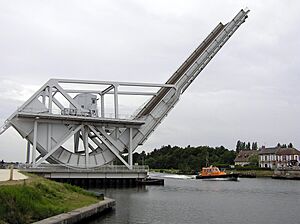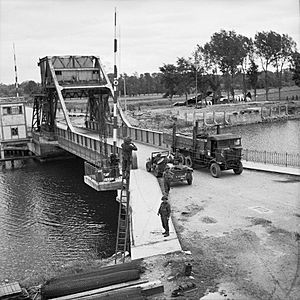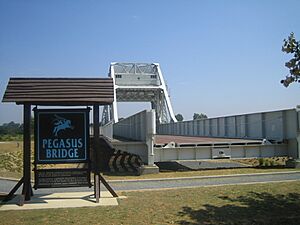Pegasus Bridge facts for kids
Quick facts for kids Pegasus Bridge |
|
|---|---|

Pegasus Bridge before its replacement
|
|
| Coordinates | 49°14′32″N 0°16′28″W / 49.24222°N 0.27444°W |
| Crosses | Caen Canal |
| Locale | Bénouville |
| Characteristics | |
| Design | Bascule bridge |
| History | |
| Opened | 1934 |
Pegasus Bridge is a famous road bridge in Normandy, France. It crosses the Caen Canal between the towns of Caen and Ouistreham. The bridge was first built in 1934 and was originally called the Bénouville Bridge, after a nearby village.
This bridge became very important during World War II. On June 6, 1944, it was a key target for Allied forces during the D-Day landings. British soldiers, arriving by gliders, captured the bridge in a surprise attack. This helped protect the Allied invasion from German counter-attacks.
Later in 1944, the bridge was renamed Pegasus Bridge. This name honors the British airborne forces who captured it. Their symbol was Pegasus, the famous flying horse from Greek myths. The original bridge is now a war memorial and part of the Memorial Pegasus museum. A new, modern bridge replaced it in 1994.
How the Bridge Works
Pegasus Bridge and its replacement are special types of bascule bridges. These are often called "rolling bridges." Instead of just turning on a hinge, they roll back on curved parts. This design allows boats to pass underneath more easily. It creates a wider opening for ships on the Caen Canal.
The Battle for the Bridge
On the night of June 5, 1944, a group of 181 British soldiers set off from England. They were led by Major John Howard. Their mission was to capture Pegasus Bridge and another nearby bridge, "Horsa Bridge," over the Orne River. These bridges were vital to stop German tanks from attacking the Allied forces landing on Sword Beach.
The soldiers traveled in six Airspeed Horsa gliders. These gliders landed very close to the bridges, surprising the German defenders. The British troops quickly exited their gliders and took control of both bridges within just 10 minutes.
Sadly, two soldiers were lost during this brave attack. Lance corporal Fred Greenhalgh drowned when his glider landed. Lieutenant Den Brotheridge was badly wounded while crossing the bridge. He was the first Allied soldier to die from enemy fire on D-Day.
One glider landed about 7 miles off target. Most of the soldiers from that glider managed to make their way through German lines. They eventually rejoined other British forces. Later, more British paratroopers arrived to help defend the bridges. They were then joined by forces from the beaches, including Lord Lovat's Commandos.
Interestingly, a young actor named Richard Todd was among the reinforcements. Years later, he would play Major Howard in the famous war movie The Longest Day.
Pegasus Bridge Today
The original Pegasus Bridge is no longer used for traffic. It is now located at the Pegasus Museum. This museum was opened in 2000 by the Prince of Wales. It stands near the eastern end of the current bridge.
The original bridge was replaced in 1994 by a wider and stronger one. The old bridge had been made longer in the 1960s to fit a wider canal. After its replacement, the historic Pegasus Bridge was saved and sold to the museum for a very small price.
Many of the soldiers who died in the June 1944 battles are buried in the war cemetery at Ranville. Lieutenant Brotheridge's grave is in the churchyard next to the cemetery. A special plaque was placed there by the Gondrée family.
The museum has a café and a small shop. The famous Café Gondrée is also nearby. It was one of the first French houses to be freed during D-Day.
There is also a place called Pegasus Wood in Leeds, England. It honors the brave soldiers who landed at Pegasus Bridge.
See also
- 92nd (Loyals) Light Anti-Aircraft Regiment, Royal Artillery
- David Wood (British Army officer)
- Horsa Bridge




